Professional Coffee Roasting Knowledge Corporate Training Barista
First, the mixing of coffee beans people need to combine coffee from different places for several different purposes. The ideal goal, of course, is to piece together a coffee that tastes better than any of them. But generally speaking, Arabica coffee from a single origin is enough to make coffee that tastes good for export; it has a delicate flavor, a soft taste and a sweet aftertaste. So there is no need for "blending" (that is, putting together coffee from different places).
The main commercial purpose of blending coffee is to reduce costs and mix coffee with coffee that is not very good. In order to improve sales profits. There is also a possible purpose, that is to put together a unique taste, the unique taste of a brand. Customers who like this taste have to go to this factory to buy it, but can't get it from other suppliers. Another advantage of this is that the taste of the blended coffee will not change no matter how the taste of the coffee from different years changes in some places.
Here we ignore other possible commercial purposes and concentrate on understanding the blending for the purpose of improving the taste and quality of coffee.
Before blending any coffee, you should first understand the taste characteristics of all kinds of coffee, and at least make it clear in your heart that the taste of the kind of coffee you want to mix can not be achieved by any single coffee. It would be a pity if the blended coffee doesn't taste better than one or more of them. It would be better not to match. If you use some pretty good quality coffee for blending, the result is likely to be so.
Although some fixed varieties of coffee can be drunk directly as individual coffee, most of the coffee has more or less defects in flavor, such as no special flavor, lack of depth, not strong enough or a certain flavor is too strong. In order to make up for these deficiencies, it is necessary to combine several kinds of coffee beans with different characteristics to create a harmonious and deep flavor. Some people think that the fun of coffee is focused on baking and blending, while drinking coffee is just enjoying the fruits of your own victory. Blending coffee is not a random mix of coffee beans. Sometimes the blending of two kinds of boutique coffee will suppress each other's unique flavor, so blending is not simply blending several kinds of boutique coffee together. Matching is just like a painter adjusting and creating charming colors in a palette, so the mixer can also blend with coffee beans to produce an attractive flavor. Therefore, it is not too much to say that matching is an art. as an artist, the assembler needs not only experience and inspiration, but also through certain scientific calculation. The emergence of works of art will not be accidental, but the outbreak of long-term accumulation. The average blended coffee does not need to use more than five kinds of coffee beans. Because if there are too many kinds of coffee beans, the situation can be very complicated. Almost only a very special expert would not be confused by so many different coffee beans. Second, the relationship between matching and baking
Do you want to bake and then mix, or do you want to mix and bake first? Which way is better?
If you have a definite recipe, of course the easiest way is to put different coffee beans together and then bake them together. But if you are trying and comparing different ingredients and proportions, you certainly want to bake all kinds of coffee beans before trying. Otherwise, every time you change the composition and proportion of the mix, you need to bake it again.
For "Vienna Coffee" (Melange) blending and small test blending, it is more suitable for independent roasting. For example, when a small amount of "Rob Coffee" needs to be added in a trial mix, the required "Rob Coffee" is the most suitable for independent roasting.
Some coffee is denser or changes in volume before and after roasting, and these beans are roasted differently from "washed" Arabica coffee. Arabica Coffee processed by the "drying method" is baked at a higher temperature. But in most cases, all kinds of coffee beans can be roasted together.
In general, all coffee beans can be roasted together. You need to consider using independent baking only when the baking effect is not ideal. At this time, independent baking can usually achieve better results. Especially for drum roaster, a relatively moderate baking degree can be found in general.
But some individual coffee beans are not easy to bake evenly. For example, Yemeni coffee, Ethiopian DP coffee beans, and so on. The uneven baking color is not a defect, only the "washed" Arabica coffee needs to be roasted evenly. The general steps and principles of matching should be clear about the following points before matching:
1. The theme of matching
What kind of flavor you want to match, that is, to determine the goal of the match.
two。 Understand the characteristics of each coffee bean
To mix coffee, you must first be familiar with the characteristics of each individual coffee and understand the subtle relationship between roasting and coffee flavor, all of which can only be achieved by tasting the cup.
3. Determine the task of participating in the blending of coffee beans
Since a variety of coffee beans are used together, it is necessary to know whether the task of each kind of coffee beans is to make her show soft bitterness, distinct acidity or thick mellow taste, etc.
Generally speaking, the following principles should be followed when matching:
1. Blending of raw beans requires the use of coffee beans with their own characteristics, and avoid using coffee beans with similar flavor. The choice of raw beans can be considered from three aspects:
Raw bean treatment method: that is, whether raw beans are treated by washing method or drying method, which has a lot to do with the flavor of coffee beans.
Producing areas of raw beans: coffee producing areas are generally divided into three major regions, including about 20 countries in Central and South America, namely, Brazil, Colombia, Guatemala, Mexico, Delvado, Jamaica and Peru, and about 10 countries in Southeast Asia, namely India, Indonesia (including Java and Sumatra) and Papua New Guinea. About 25 countries in the Arab and African regions, namely, Ethiopia, Kenya, Tanzania, Arabia, Uganda and so on.
Coffee bean flavor: refers to the coffee bean flavor of sour, bitter, sweet, alcohol which is more prominent, or all aspects of more balanced neutral beans. Now the most commonly used raw beans are Brazil, Colombia and Mocha.
two。 The number and proportion of coffee beans involved in blending
Since it is a blending, it naturally refers to the blending of more than two kinds of raw beans, but a special example is that it can also match the same kind of coffee beans with different roasting degrees, or even the new crop and aged coffee or old crop of the same kind of coffee beans, so the type referred to in the blending is no longer a coffee variety in a narrow sense, but extends to the flavor of coffee in a broad sense. Generally use 2 to 6 kinds of coffee beans when blending, too many kinds will not be able to show the unique flavor of coffee. Blended coffee usually does not take the 1:1 blending ratio, because this may suppress each other's unique flavor, so the blending must be primary and secondary in order to produce a better taste than a single coffee. If you want the coffee to taste complex and changeable, you can reduce the proportion of raw beans, and vice versa.
3. The blending of coffee depends on constant attempts, so a blending schedule should be drawn up mathematically before blending, and then the best plan should be determined through the process of blending-tasting cups. Don't think that this is a negative and stupid approach. In fact, a good cup of coffee can only be made by the experience, inspiration and tireless attempt of the blender. Third, the concept and principle of coffee roasting, as the name implies, roasting is to provide heat to coffee beans, so that a series of chemical changes occur inside. Raw coffee beans show the unique color, aroma and taste of coffee by roasting. Every coffee bean contains fragrance, sour taste, sweet taste and bitter taste. How to release it incisively and vividly depends on the heat of baking.
From the insipid raw beans to the mellow aftertaste in the cup, baking is a very important step in the long journey of every coffee bean to outline its character and nurture its fragrance. Coffee beans are about 20 minutes long (inversely proportional to the temperature) and the temperature is as high as more than 200 degrees Celsius. In the process of dialogue with hot cuts, coffee beans have undergone many chemical changes. First of all, the starch in raw beans will be converted into sugars and acids because of high temperature, while substances such as cellulose will be carbonized to varying degrees. Water and carbon dioxide evaporate, while proteins are converted into enzymes, which combine with the rest of the fat to form an oil film on the surface of coffee beans. Coffee beans swell after roasting, giving off a primary explosion, a secondary explosion, a sound like popcorn, and loss of moisture. But because the skin on the surface of coffee beans is very tough, we usually don't see coffee beans crack like popcorn. From raw beans, light roasting, medium roasting to deep roasting, the water is released again and again, the weight is reduced, but the volume slowly expands, the color of the coffee beans deepens, the fragrant oil is gradually released, and the texture becomes crisp.
In raw beans, there is a lot of chloric acid, which gradually disappears with the baking process, releasing familiar and pleasant fruit acids, such as acetic acid, citric acid and malic acid in wine. Baking moderately presents these sour flavors.
We often see that roasted coffee beans have different shades of color. On the one hand, this may be due to different types of individual coffee beans; on the other hand, the main reason for this color difference is the degree of roasting. In the most popular language, the degree of baking can be interpreted as the heat of baking. Take the most classic example of carbonated coffee, a French roasted coffee that is highly carbonized, dark brown and carbon black due to its deep roasting (either because of the high temperature during baking, or because of the long baking time, or both, depending on the situation). It is generally believed that carbonized coffee tastes bitter, which comes not only from caffeine but also from carbonized coffee beans.
The principle of baking: the most important thing in baking is to be able to stir-fry the inside and outside of the beans evenly. First of all, the moisture in the beans will be discharged smoothly through firepower. If this step is too hasty, it will be spotted, and the taste will be astringent and choking.
80% of the taste of coffee depends on roasting, so roasting is an important process for brewing good coffee. If the baking technology is good, the beans will be large and swollen, with no wrinkles and luster. Roasting coffee beans into their ultimate characteristics is the ultimate goal of baking.
The flavor of coffee not only depends on the variety of coffee, roasting is also a decisive factor.
Basically, the roasting of coffee is a kind of high-temperature coking, which completely changes the substances inside the raw beans, produces new compounds, and recombines to form aroma and mellow flavor. This effect will only occur at high temperature. If only low temperature is used, it will not cause decomposition, and no matter how long it is roasted, coffee beans will not be cooked. IV. The process and stage characteristics of coffee roasting
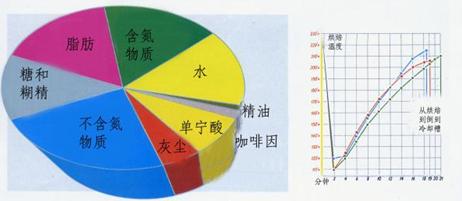
Baking process most people think that baking is nothing, just use fire to cook raw beans. In fact, in the process of coffee processing, roasting is the most difficult step, it is a kind of science, but also an art, so in Europe and the United States, experienced roasters enjoy a highly respected status. Baking can be divided into the following three stages
1. Drying
In the early stage of baking, the raw beans begin to absorb heat, and the water inside gradually evaporates. At this time, the color gradually changed from green to yellow or light brown, and the silver film began to fall off, you can smell a faint smell of grass. The main function of this stage is to remove moisture, which accounts for about half of the baking time, because water is a good heat transfer conductor and helps to bake the internal material of coffee beans. Therefore, although the aim is to remove water, the baker will make good use of the temperature of the water and properly control it so that it will not evaporate too quickly; in general, it is best to control the water to reach the boiling point and turn into steam in 10 minutes. At this time, the internal material is fully cooked, and the water begins to evaporate, rushing out of the outside of the coffee beans.
2. High temperature decomposition
Baked to about 160 degrees Celsius, the water inside the beans will evaporate into gas and begin to rush out of the outside of the coffee beans. At this time, the interior of the raw bean changed from endothermic to exothermic, resulting in the first burst sound. After the bursting sound, it turns to endothermic again, and the pressure inside the coffee bean is extremely high, up to 25 atmospheric pressure. Heat and pressure begin to deconstruct the original tissue to form new compounds that create the taste and taste of coffee; at about 190 degrees Celsius, the transition between endothermic and exothermic occurs again. Of course, high temperature cracking continues to occur, coffee beans from brown to dark brown, gradually entering the stage of re-baking.
3. Cooling
Coffee must be cooled immediately after roasting, quickly stop the pyrolysis at high temperature and lock the flavor. Otherwise, if the high temperature in the beans continues to work, the aromatic substances will be burned. There are two cooling methods: one is air-cooled and the other is water-cooled. The air-cooled type requires a lot of cold air to cool the coffee beans quickly within 3-5 minutes. In the field of professional baking, large roasters are equipped with a tray with a rotatable driving arm; when the baking is completed, the beans are automatically fed into the tray, and the fan at the bottom of the tray is immediately activated to blow cold air. And the pushing arm stirs the coffee beans to cool them. Although the speed of the water-cooled type is slow, it is clean and does not pollute, and it can better retain the aroma of the coffee, so it is used by the selected coffee industry. The water-cooled method is to spray a layer of water mist on the surface of the coffee beans, allowing the temperature to drop rapidly. As the amount of spraying water is very important, it requires precise calculation and control, and will increase the weight of baked beans, which is generally used in large-scale commercial baking.
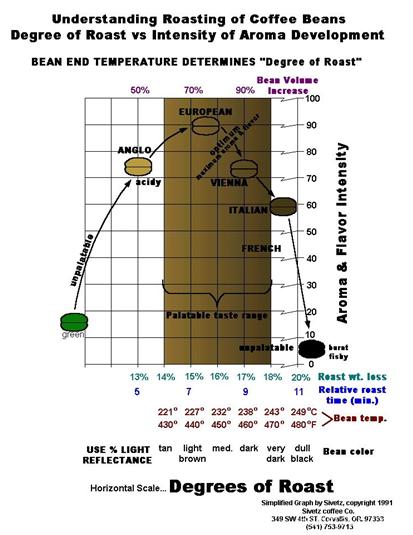
Baking degree and characteristics from the baking degree, the deeper the baking degree, the stronger the bitter taste; the shallower the baking degree, the stronger the sour taste. The choice of baking degree depends on the characteristics of the coffee bean itself. for coffee beans with strong bitterness and light sour taste, they generally choose a moderate and shallow roasting degree.
1. Shallow baking (Light)
The most mild fried culture, no fragrance and concentration to speak of, the beans are not yet ripe, with the green taste of raw beans, not suitable for grinding and drinking. It's usually used as an experiment.
2. Deep shallow baking (Cinnamon)
Also known as cinnamon baking, for the general popular degree of frying, leaving a strong sour taste. The color of beans is quite similar to that of cinnamon, so it is also called cinnamon baking and its sour taste is aggravated. It is favored by people in the western United States.
3. Shallow medium baking (Media)
The color deepens, easy to extract the original taste of coffee beans, mellow, sour and delicious. Mainly used for mixing coffee.
4. Medium baking (High)
Coffee has a stronger flavor and a lighter sour taste, which is the general roasting method of coffee beans. The sour taste is neutralized and bitter, suitable for coffee such as Blue Mountain and Kilimanjaro. It is loved by Japanese and Nordic people.
5. Deep medium baking (City)
Also known as city baking, bitter taste is stronger than sour taste, almost no sour taste, unique flavor. Coffee suitable for Colombia and Brazil is very popular in New York.
6. Normal baking (Full City)
Also known as city-wide baking, suitable for brewing iced coffee. No sour taste, mainly bitter taste, bitterness will be aggravated, but high-quality beans will have sweet taste. It is used for iced coffee and is preferred by people in Central and South America.
7. French baking (French)
French baking method, slightly black color, strong bitterness, but also ooze oil, bitterness and concentration are deepened. Coffee used for steam pressurizer.
8. Deep baking (Italian)
Also known as Italian baking, the deepest baking degree, the beans are black and bright, the surface is oozing oil, the bitterness is very strong. At this stage, coffee beans have been seriously carbonized, and it is difficult to distinguish the taste of one kind of coffee bean from another. For Italian steam pressurized coffee.
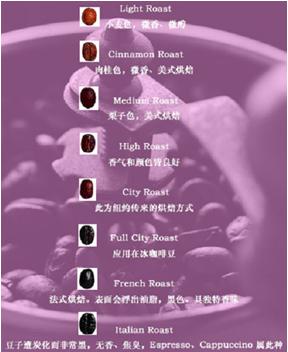
Baking characteristics all over the world cities all over the world have their own preference for baking.
In Tokyo, micro-deep medium baking is more popular, but slowly it also tends to deep baking. In the West, deep baking has been popular since ancient times.
New York, as its name suggests, generally prefers urban baking, but because it is inhabited by different races of people, it sells coffee beans of different roasting levels, which are quite varied.
Vienna prefers deep baking. The French prefer French baking, while Italians often use Italian baking.
However, in recent years, Italian baking (the most commonly used deep roasting in Brazil and Italy) has been widely used in Europe and the United States, and the coffee made by steam pressurizer is still popular.
Deep roasting of Ethiopian coffee beans would be a waste. Because that would lose the unique characteristics of this coffee. Black roasting of Yauco and Kona coffee beans is also bad, because you will lose the classical flavor you pursue when you buy it.
When some coffee beans are roasted black, new and interesting qualities will be derived. Mexican coffee beans produce an interesting sweetness when roasted in black.
Guatemala Antigua coffee beans seem to retain their sour and fruity flavor when they are deeply roasted, which is difficult for other coffees.
Sumatran coffee beans are usually full-grained, but are below medium acidity, lose acidity when roasted deeper, and easily turn into sugar paste.
Generally speaking, the darker the baking, the lower the quality. Deeper roasting means losing most of the flavor of the coffee beans. Roast coffee beans at home
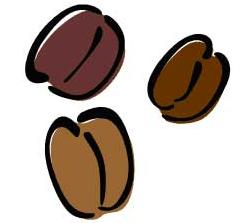
The hardest part of coffee-related activities is baking coffee beans at home. When making high-quality coffee, whether the beans are fresh or not is very important.
The easiest way is to bake coffee beans in the oven. The biggest advantage of this is that it adjusts the temperature so that the smell of roasted coffee does not pervade your home. Heat the oven to 230 degrees in advance. Remember to keep the coffee beans well ventilated and don't spread the beans too thick. After baking for about 10 minutes, observe the change of color. Pay attention to the crackling sound of coffee beans and check the color all the time. When the coffee beans are only a little lighter than you want, remove them from the oven to cool. The residual heat will cause the coffee beans to continue to be heated for 2 Mel for 4 minutes.
Home baking stoves can also be used, but the best is the traditional flat-bottomed pan or popcorn (popcorn) model. Use a handle to manipulate two vertical pieces of metal inside the machine, which can rotate the coffee beans during baking. This can be bought in a second-hand store or a good kitchen utensils store, where you can also buy inexpensive oven thermometers.
After the coffee is roasted, take them out of the grill, put them in a heat-resistant bowl, and put the bowl by the window or outdoors.
The operation of crushing roasted coffee beans into powder is called grinding. The props used to grind coffee beans are called grinders.
The ideal time to grind coffee is before cooking. Because the ground coffee is easy to oxidize and lose its flavor, especially when it is not properly stored, the coffee powder is easy to change flavor, and it is naturally impossible to cook mellow coffee.
Some people are afraid of trouble or don't want to buy more bean grinders. They usually buy ready-made coffee powder when drinking coffee at home. At this time, they should pay special attention to storage. If the climate is humid, it is best not to place coffee powder at room temperature after opening. A more appropriate way is to put it in a sealed jar and refrigerate it, and do not place it with garlic, fish and shrimp and other heavy-flavored food. Because the coffee powder is easy to absorb, a careless coffee becomes a strange taste coffee, then even the best quality coffee will be spoiled. However, some people put the cooked coffee powder in the refrigerator as a deodorant, which is a good way to make the best use of things.
When grinding beans, the size of the powder depends on the way it is cooked. Generally speaking, the shorter the cooking time, the finer the ground powder; the longer the cooking time, the thicker the ground powder. In terms of actual cooking, the ESPRESSO machine takes a very short time to make coffee, so the grinding is the finest, and the coffee powder is as fine as flour; it takes more than a minute to cook coffee by plugging the air, and the coffee powder is medium-sized grinding; American filter coffee takes a long time to make, so the coffee powder is the thickest.
Grinding coffee powder with the right thickness is very important for making a good cup of coffee, because the extraction of water-soluble substances in coffee powder has its ideal time, if the powder is very fine and cooked for a long time, resulting in excessive extraction, the coffee may be very bitter and lose its aroma. On the other hand, if the powder is coarse and cooked too fast, resulting in insufficient extraction, the coffee will be tasteless because it is too late to dissolve the water-soluble substance in the powder. Coffee Grinding process (1) principles of Grinding
Generally speaking, a good grinding method should include the following four basic principles:
1. The degree of grinding suitable for brewing and cooking should be selected.
2. The temperature of cattle produced during grinding should be low.
3. The powder particles after grinding should be uniform.
4. Grind before cooking.
No matter what kind of grinder is used, it is bound to generate heat by friction in operation. Most of the fine substances are highly volatile, and the heat of grinding will increase the speed of volatilization, so that the aroma of coffee is lost in the air. After the coffee bean is ground, the cell wall will completely disintegrate, the area of contact with air will increase a lot, the rate of oxidation and deterioration will become faster, and the coffee will lose its flavor within 30 seconds to 2 minutes. Therefore, it is recommended not to buy coffee powder, it is best to buy coffee beans, grinding before drinking, grinding should be brewed as soon as possible.
Before the invention of the bean grinder, people used stone pestles and bowls to grind coffee beans. A doctor abroad once experimented with this ancient tool and compared it with a modern bean grinder. It is said that the coffee powder made from pestles and stone bowls is the most mellow.
According to logical reasoning, the pestle cracked the coffee bean naturally by impact, which should not destroy the cell wall and retain the excellent substance of coffee. However, in modern life, it is almost impossible for people to use pestles and stone bowls to grind coffee beans, so it is particularly important to choose a good bean grinder.
(2) the method of grinding
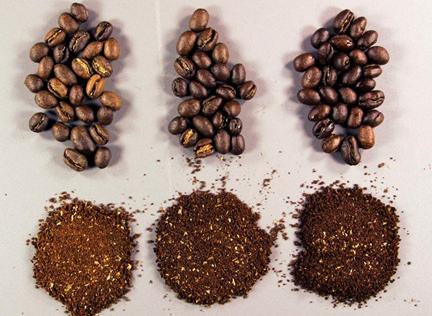
According to the size of coffee beans, the grinding methods can be divided into rough grinding, medium grinding and fine grinding. Use the appropriate grinding method according to the coffee utensils. There is also medium fine grinding or finer and finer grinding than fine grinding (powdered coffee powder).
1. Fine grind: the particles are fine, the same size as sugar.
2. Medium grind: the particles are the same size as the mixture of granulated sugar and crude sugar.
3. Rental grinding (Regular grind): the particles are thick, as big as coarse sugar.
(3) the secret of grinding
1. The grinding tool for coffee beans is a bean grinder. There are three kinds of bean grinders:
(1) Manual rotary bean grinder for household use. It is suitable for leisure people with small demand, large particles and plenty of time.
(2) Electric bean grinder for household use. Can be ground into a variety of particle size coffee powder, can be ground out of 6 people at a time.
(3) Professional use of electric bean grinder. For commercial use, about a pound of coffee powder can be ground at a time.
2. The following two points should be paid most attention to when grinding coffee beans:
(1) reduce the heat of research. Grinding heat will cause the aroma of coffee to dissipate early.
(2) the particle size is uniform. Uneven particle size will lead to uncontrollable brewing time.
So if you use a family-style manual bean grinder, you should rotate gently so that it does not produce friction heat as much as possible. To sum up, if you consider the quality, quantity, time and convenience of grinding beans, the use of electric bean grinders for home use will be the best choice. Coffee grinder bean grinder has a variety of different brands and models, the grinder that can adjust the thickness of grinding beans is more ideal. When grinding with a bean grinder, don't grind too much at one time, just enough for one use. Because the longer the bean grinder is used at one time, the easier it is to heat up, which indirectly causes the coffee beans to be heated and leads to the loss of aroma, thus affecting the aroma of the coffee.
Coffee beans contain oil, so the bean grinder must be cleaned after grinding, otherwise the grease will be fouled and will smell stale after a long time, and even the most advanced beans will be ground into a strange-smelling powder. After each use of the bean grinder, be sure to wipe the blade table with a wet towel and clean the plastic top cover with warm hot water. However, we should pay special attention to the American popular flavored coffee, the added flavor is strong and strong, and will remain for a long time. Therefore, it is best to put two spoonfuls of sugar in before cleaning to beat the flavor. Of course, it is better for a grinder to grind only the same kind of beans, so that there is no problem of mixing.
(1) Propeller bean grinder
This kind of bean grinder uses a motor to turn a propeller blade to grind coffee beans into powder. Coffee beans will be chopped to pieces and a lot of flavor will be lost. Therefore, this kind of propeller bean grinder is not commonly used. However, because it is cheap, small and does not take up space, some homes and offices still use it frequently. The propeller bean grinder mainly has the following disadvantages:
1. High temperature is formed during grinding.
Compared with other bean grinders, this kind of bean grinder has the fastest speed and is easy to form high temperature after high-speed friction with coffee beans. However, the boiling point of aromatic substances is very low, so the aroma of coffee will be lost in the high temperature of the grinding process, thus discoloring the coffee.
2. Uneven grinding
This kind of grinding opportunity will cut the coffee beans randomly, and the powder formed is either too thick or too fine (too fine coffee powder will produce bitterness), which is difficult to be uniform. Especially in a large number of grinding, often floating on the top of the beans, easy to produce too thick coffee grains. This tends to form a random distribution, with a high proportion of too fine and too coarse powder particles.
In order to overcome this disadvantage, a small amount of grinding can be used, and hold the bean grinder by hand, and shake the lid up and down with your thumb, so that the blade can be cut evenly to the coffee grains.
3. Form a block
When grinding beans, the high-speed spiral blade will make the coffee powder form a whirlpool, but because the centrifugal force is too large, it will make the ultra-fine powder form lumps and stick around, which will prevent hot water from soaking coffee averagely, resulting in uneven extraction.
4. The degree of grinding cannot be set.
This kind of bean grinder does not have the function of setting the grinding degree, so it can only be determined according to the grinding time. The general grinding time is about 6-10 seconds, which is suitable for filter kettles, follicular cups and air stoppers. However, espresso requires very fine grinding, which may take more than 20 seconds, when the friction temperature will continue to evaporate the aroma of the coffee.
5. Dangerous switch design
In design, this kind of grinder usually uses the pressure of closing the lid to start the switch and rotate the spiral blade. When putting beans or cleaning, if you accidentally press the switch and the finger is right near the blade, the consequences will be unimaginable. It is suggested that the plug should be unplugged at ordinary times, then plugged in before grinding the beans, and unplugged immediately after use; when handling and cleaning, the power supply should also be cut off. In addition, the plastic lid above can be cleaned with water, but the inside and outside of the fuselage can not be stained with water, can only be wiped with a dishcloth.
(2) hand-operated bean grinder
For more than 100 years, the design of the hand-operated bean grinder has hardly changed, and even the latest models tend to be classical and elegant. This kind of bean grinder needs to rotate the rocker by hand, turn the iron sharpening knife inside, crush the coffee beans into a fine powder and drop them in the box below. Strictly speaking, the internal sharpening knife is not a knife, because it does not have a sharp blade or sawtooth, but a tapered grinding iron with an angle. It grinds the coffee beans by rolling, which is similar to the ancient mortar and pestle, and can best retain the aroma of the coffee.
Although it is a bit hard to use a hand bean grinder, and the speed is not fast, it can grind coffee powder with uniform particles, coupled with the lowest friction temperature during grinding, so it is not easy to destroy the delicacy of coffee. It is very suitable for drip filter and drip bubble brewing methods. In addition, the hand-held bean grinder makes the least noise and has always been a favorite of coffee brewers.
The hand-operated bean grinder usually has a ring-shaped knob between the rocker and the main body, which can grind down to produce finer coffee powder. this bean grinder can grind coffee powder of medium to fine size, but it is impossible to grind very fine powder. so it's not suitable for grinding espresso powder.
(3) Sawtooth bean grinder
The saw-tooth bean grinder can grind uniform coffee powder quickly and steadily, but the price is higher.
The operation method of this kind of bean grinder is quite simple, as long as you follow the instructions on the instructions, it can be easily used. Generally speaking, it has two setting functions, one is the grinding degree setting, the other is the grinding time setting. The degree of grinding is mostly expressed in Arabic numerals, and the smaller the number is, the finer the grinding is. Some clearly indicate the grinding range of various brewing methods. For example: Filter, Espresso, etc. The range of Filter is suitable for drip and follicle brewing methods, while Espresso is suitable for espresso, and the instructions will also specify the application of various grinding degrees.
The bean grinder has a funnel-shaped container containing unground beans. The longer the time is set, the more beans will fall into the grinder, the more coffee will be ground. As the fresh-keeping effect of the box is not good, it is recommended to drink as much as possible and drink it after grinding it at one time. Other beans can be stored in vacuum cans or fresh bags and can be grinded next time.
1. Types of sawtooth bean grinders
There are two types of sawtooth grinders: one is a planar sawtooth knife and the other is a three-dimensional conical sawtooth knife.
(1) Planar serrated cutter
The flat machine consists of two annular blades with sharp sawteeth on the circumference. After starting, the coffee beans are brought between the blades and are instantly cut and crushed into fine particles. As far as household appliances are concerned, the flat sawtooth grinder is the closest to a commercial large bean grinder, similar to a bean grinder in a coffee shop.
(2) three-dimensional conical serrated cutter
The tapered bean grinder is composed of two pieces of tapered iron, the surface of which is covered with serrated teeth. The gap between the two pieces of iron is where the coffee beans are ground into powder. The conical serrated cutter produces the lowest friction temperature and can form uniform grinding. Both commercial machines and manual bean grinders use conical serrated cutters.
2. Matters needing attention in the selection and purchase of sawtooth bean grinder
The bean grinder with higher power has faster grinding speed, the coffee powder stays in the sawtooth room for a shorter time, and can grind the low-temperature coffee. Generally speaking, the power of bean grinder is between 70 watts and 150 watts, and the higher the power, the better.
The grinding effect of some coffee grinders is very poor, and the coffee powder is not fine enough. When brewing espresso, the extraction is insufficient, making the finished product tasteless, so for grinding espresso, special attention should be paid to the precision of the grinder to make sure that it can grind a uniform and meticulous coffee powder, so as to brew a good coffee.
(this article is reprinted)
Important Notice :
前街咖啡 FrontStreet Coffee has moved to new addredd:
FrontStreet Coffee Address: 315,Donghua East Road,GuangZhou
Tel:020 38364473
- Prev
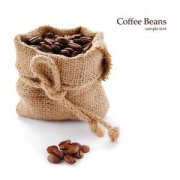
Roasting determines the taste of coffee basic knowledge of coffee beans
Generally speaking, each coffee cherry contains two raw beans, and the fragrance is still hidden, waiting to be discovered. In raw beans, it contains a lot of chloric acid. As the baking process, chloric acid will gradually disappear, releasing familiar and pleasant fruit acid-such as acetic acid, citric acid, malic acid in wine. Baking is just right, it can present these beautiful sour taste moderately; on the contrary,
- Next
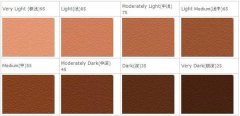
Coffee roasting basic knowledge Coffee roasting degree Resolution Chart
American Coffee Association (SCAA) roasting standard this standard uses infrared caramelization tester technology (Agtron) to measure the color of coffee beans to determine the roasting degree of coffee, and the color is divided into eight equal parts into eight standard color blocks for coffee industry as roasting identification. The above colors are for reference only according to the roasting degree preferred by each country. This is also coffee roasting.
Related
- Beginners will see the "Coffee pull flower" guide!
- What is the difference between ice blog purified milk and ordinary milk coffee?
- Why is the Philippines the largest producer of crops in Liberia?
- For coffee extraction, should the fine powder be retained?
- How does extracted espresso fill pressed powder? How much strength does it take to press the powder?
- How to make jasmine cold extract coffee? Is the jasmine + latte good?
- Will this little toy really make the coffee taste better? How does Lily Drip affect coffee extraction?
- Will the action of slapping the filter cup also affect coffee extraction?
- What's the difference between powder-to-water ratio and powder-to-liquid ratio?
- What is the Ethiopian local species? What does it have to do with Heirloom native species?

